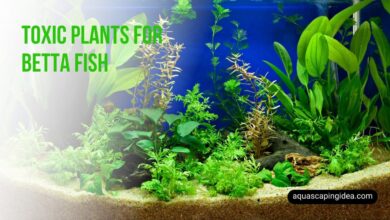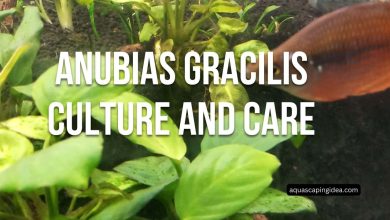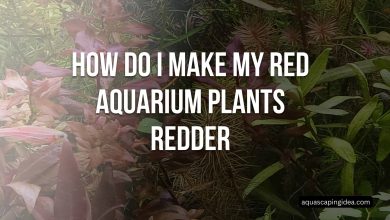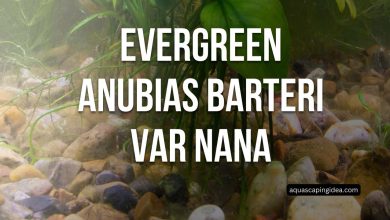Low Tech Background Aquarium Plants: Aquascaping for Beginners

For aquarium hobbyists who want the beauty of live plants without high-maintenance CO2 and lighting systems, low tech background plants are an excellent option. These hardy, slow-growing plant varieties thrive with basic aquarium setups and minimal intervention. Classic choices like Java fern, Anubias, and Amazon sword plants derive most nutrition from the water itself rather than planted roots.
Their broad leaf shapes provide lush, naturalistic backgrounds that contrast well with smaller foreground plants. Being robust and undemanding, low tech background plants are also perfect for beginner aquarists seeking to add greenery without investing in advanced equipment. With simple fertilization and trimming, these undemanding aquatic plants can provide a jungle vista in almost any freshwater aquarium.
Benefits of Low-Tech Planted Tanks
High-tech aquariums with pressurized CO2 and high-intensity lighting can produce jaw-dropping aquascape designs. However, these systems require regular trimming, fertilization, water testing and equipment maintenance. For the casual hobbyist, this level of effort can sap the relaxing joy right out of the hobby.
Low-tech planted tanks offer a lower-stress alternative. By selecting easy-care species adapted to low-light, no-CO2 conditions, you can create a self-sustaining underwater garden.
This more natural method provides numerous advantages:
- Fewer demands on your time, allowing you to just sit back and enjoy observing your aquarium.
- Lower equipment costs and electrical bills. No need for specialized CO2 systems and high-powered lighting.
- Enhanced water quality. Plants naturally filter contaminants without elaborate filtration required.
- Natural algae control. Fast-growing stem plants outcompete nuisance algae.
- Shelter and enrichment opportunities for fish. Plants provide security, explore space and optimal spawning sites.
Hardy low-tech plant species can thrive under regular aquarium lighting with liquid fertilization only when needed. By understanding these plants’ preferences and proper selection for your setup, you can create a hassle-free living landscape.
Choosing Background Plants
Background plants play an integral role defining the overall look and feel of your aquarium layout. Typically taller growing varieties, they anchor the rear and sides of your aquascape composition. This provides depth and scale while accentuating focal point areas in the mid and foreground.
When selecting background plants, you want hardy, fast-growing varieties that can quickly establish balance in your system. The following key considerations will guide you in finding suitable low-tech options:
Lighting Requirements
Most standard aquarium lighting provides medium to low intensity illumination in the low to moderate range. Selecting plant species suited to these lower light conditions is key:
- Low light: 15-30 micromoles of PAR
- Medium light: 35-50 micromoles of PAR
While some species tolerate shady spots, faster growers prefer at least medium lighting to avoid internodal stretching. Combine variable heights and growth forms to create depth and natural aesthetic.
Growth Rate
When first establishing equilibrium in planted tanks, faster growing stems outcompete algae and aid water quality as they spread. Choose quick growing background varieties to quickly create balance:
- Fast growers: >2 inches per month
- Moderate growers: 1-2 inches per month
Hardiness & Care Requirements
You want durable plants that can withstand some variability in water parameters rather than demanding species requiring high maintenance. Prioritize undemanding, resilient choices.
- Tolerates wide temperature range
- Withstands pH fluctuations
- Grows in variety of substrates
- Little to no CO2 injection required
- No frequent trimming or propagation needed
Overall Look & Feel
Consider the visual impact you want your background plants to contribute in terms of color, texture, form and density. Do you desire an orderly Dutch style garden or wild jungle valise? Match different heights, leaf shapes and growth habits to realize your vision.
Compact Swordplants – Reliable Staples
Swordplants remain one of the most popular and trusted background options, especially for low-tech beginner friendly tanks. These hardy, heavy root feeders thrive slowly releasing nutrients from the substrate. They require little intervention once established.
While Amazon swordplants can overtake smaller tanks, more compact varieties provide suitable scale for most systems. The following make excellent low maintenance background choices:
Kleiner Bar Sword (Echinodorus parviflorus ‘Tropica’)
- Slow-moderate growth to 16 inches tall and wide
- Robust roots stabilize slopes
- Durable green leaves with reddish tinge
- Low to moderate light requirements
Ozelot Green (Echinodorus ‘Ozelot’)
- Moderate growth 16 inches tall, 6 inches wide
- Graceful green leaves with dark spots
- Tolerant of shade from other plants
- Unfussy when planted in groups
Red Flame Amazon (Echinodorus ‘Red Special’)
- Moderately quick growth to 20 inches tall
- Adds vibrant reddish color among green plants
- Withstands some variability in conditions
- Filters water while protecting fry
Durable Java Ferns – Beginner Friendly Epiphytes
Java ferns represent classic low-tech options, adapting even to low-light tanks. These epiphytes feed from the water rather than root systems, gathering nutrients from leaves and rhizomes. They thrive when attached to hardscape, rock and driftwood, dimming light to contrast colorful fish and foreground plants.
Windelov Java Fern (Microsorum pteropus ‘Windelov’)
- Lush delicate foliage up to 14 inches high
- Vibrant dark green leaves with attractive veining
- Tolerates wide temperature and pH range
- Easily tied to décor with thread or gel
Narrow Java Fern (Microsorum pteropus v. ‘narrow leaf’)
- Slender structured green leaves reach 12 inches
- Contrasts broad-leaf plants for textural depth
- Best left alone to grow at its own pace
- Simple rhizome propagation during pruning
Undemanding Anubias Varieties – Low Light Loving Leaves
Like java fern, hardy anubias thrive under low to moderate light, preferring attached rather than buried root structures. Their broad cascading leaves provide shelter for shy inhabitants while creating depth and texture paired among fine-leaved stems.
Giant Anubias (Anubias barteri var. ‘Gigantea’)
- Largest broad leaves grow over 14 inches tall
- Withstands low light and minimal fertilization
- Robust dark green color highlighted with central vein
- Grazes hardscape elegantly when attached
Hastifolia (Anubias barteri v. ‘Hastifolia’)
- Distinct spear-shaped leaves with white stems
- Tolerates wide temperature fluctuations
- Filters nutrients as substantial roots spread
- Slow grower remains compact up to 12 inches tall
Vallisneria – The Versatile Corkscrew Val
A longtime aquarist favorite across experience levels, Corkscrew Val (Vallisneria americana) provides lush, twisted green foliage reliably even in low tech setups. They display beautifully on their own or combined with shorter accent plants surrounding.
- Moderately paced growth 12+ inches tall
- Soft textured leaves gently curl creating depth
- Traps debris improving water quality
- Withstands some crowding and shade
- Tolerates variety of substrates without much root nourishment needed
Cabomba – Gentle Flowing Stems for Ambience
Cabomba makes an excellent background choice, rapidly spreading lush vegetation with minimal intervention. Their softly complex leaves sway gently in the current, providing tranquility and contrast colors. Being rapid growers, they aid newly setup tanks while integrating smoothly with other plants.
Carolina Fanwort (Cabomba caroliniana)
- Bright green fine leaves in flowing bushy form
- Dense visually smooth mat as background
- Quickly adapts and establishes equilibrium
- Integrates pleasingly with other shade lovers
- Shelters fry while harboring infusoria
Purple Cabomba (Cabomba pulcherrima)
- Intense reddish leaves above bushy bases
- Beautiful floating or planted grouping
- Rapidly fills out erect leafy thickets
- Tolerates being uprooted and replanted
- Can be trimmed into hedges if desired
Low Tech Tank Guidelines
While plant selection forms the foundation, successfully growing thriving low-tech backgrounds also requires following some core guidelines for planted tank essentials:
Lighting Duration
- Provide 8-10 hours of light daily
- Use timer to ensure consistent stable photoperiod
Substrate System
- Nutrient-rich substrate supports healthy root growth o Laterite clay mixes best for heavy root feeders o Sand also suitable for java fern and anubias
- 2-3 inch depth provides stability while preventing anaerobic pockets
Liquid Fertilization
- Use comprehensive blends like Seachem Flourish once or twice a week
Algae Control
- Start with heavy plant mass from outset
- Introduce algae eaters like nerite snails and otocinclus
- Manually remove algae before it establishes by gently wiping leaves
- Use blackout periods if algae starts smothering plants
Avoiding Beginner Pitfalls
When first cultivating aquatic plants, it helps being aware of common missteps. Steer clear of the following to give your background plants their best shot:
Insufficient Planting Density
Start with plenty – at least 2-3 bunches per focal area. This prevents algae taking hold while plants acclimate and start spreading.
Inappropriate Lighting Moderate intensity promotes lush leafy growth without fueling nuisance algae. Pay attention to manufacturer PAR ratings when selecting aquarium lights.
Buried Rhizomes
Only plant true aquatic rooting species. Leave Java ferns and anubias attached to hardscape so their rhizomes get water flow. Make sure crown isn’t buried.
Deep Vacuuming
While removing mulm buildup, be gentle around roots during water changes. Stir gravel minimally around plants or they may uproot.
Frequent Trimming
Allow low-tech plants to grow at their natural pace, only trimming diseased or dying leaves. Propagate as needed.
Aquascape Design Inspiration
Before selecting your plants, consider the overall look you envision for your underwater layout. Do you prefer neatly manicured arrangements or wild jungle style valises? Mix colors, leaf textures and scale to realize your theme.
For Dutch aquascape inspiration, combine:
- Broad Ozelot Sword
- Red Flame Amazon Sword
- Spiky Hastifolia
- Organized rows of Val Corkscrew behind stones
Create depth with:
- Towering Giant Anubias on driftwood
- bushy Purple Cabomba filling in behind rocks
- Kleiner Bar Sword accent planting
EVoke wild vibrancy mixing:
- Massive stands of Corkscrew Val
- Variegated Manzanita branching through
- Chaotic Bushy growths of Fanwort
- Contour hugging mats of narrow leaf Java Fern
No matter which inspiration you follow, resist overcrowding different species. Allow enough space for each variety to highlight its distinctive features as they mature.
Propagating Aquatic Plants
As background plants grow dense, you’ll need to thin and propagate them to avoid overcrowding. This maintains optimal health while generating extras to expand landscape design elements.
Stem Plants Snip stem plants just below leaf nodes which will generate adventitious plantlets. Replant tops while bottoms left in situ will often sprout bushy side shoots. Examples include cabomba.
Rhizome Plants
Use a clean, sharp knife or razor to divide established java fern and anubias growths at the rhizome, ensuring at least 3 leaves each. Reattach extras with gel or ties.
Rosette Plants
Gently uproot rosette type plants like Amazon swords to separateoffsets from the parent crown. Replant offsets an inch deep allowing space between groups.
Common Problems and Solutions
While less demanding than high-tech setups, low-tech tanks aren’t completely free of occasional issues. Being able to identify and rectify common problems keeps your aquatic landscape thriving.
Brown Leaves Potential Causes: Low nutrients or CO2 – Add comprehensive supplement
Insufficient light – Reduce background plants shading
Remedy: Prune damaged growth, enhance flow, supplement nutrition
Holes, Discolored or Curling Leaves Culprits: Snail grazing, potassium deficiency, poor water quality
Fixes: Manually remove snails, increase water changes 30%, increase K dosing
Stunted Growth Triggers: Compacted substrates, anaerobic gas pockets in gravel Cures: Gentle substrate aeration without uprooting plants
Algae Takeover Contributors:
Excess light, organics, low plant mass Solutions: More plants, reduced light duration, clean hardscape, supplement CO2, manual removal
No Aquascape is Completely Maintenance Free
While minimal compared to high-tech arrangements, low-tech aquascapes do still require some basic care long term to continue thriving. Consistently adhere to the following habits rather than just setting and forgetting your planted tank:
- Weekly maintenance with 10-20% water changes, topping off for evaporation
- Monthly filter maintenance without disrupting bacterial colonies
- Remove decaying plant matter during routine upkeep
- Test pH, GH, KH levels every 3-4 months
- Fertilize any displaying deficiency signs
- Prune and propagate bushy growths every 2-3 months
- Monitor inhabitants and plants adjusting parameters as needed
- Enjoy observing daily while feeding and interacting with inhabitants!
FAQs
What is considered low-tech when it comes to aquariums?
Low-tech planted aquariums rely on more natural methods and lower-maintenance equipment. This typically includes standard aquarium gravel or sand substrates, moderate intensity lighting, and no pressurized CO2 injection or automation. Low-tech tanks house hardy plant species undemanding of frequent fertilizer dosing, trimming and water testing.
How do I jumpstart a low-tech planted tank?
Kickstart success by beginning with heavy planting especially fast growing stem varieties, choosing hardy species suited to your tank size, lighting and setup. Include clean up crew algae eaters, follow lighting duration and fertilization guidelines and give plants time to establish equilibrium in the mini-ecosystem.
Why are my aquarium plants turning brown?
Aquatic plants can turn brown from insufficient nutrients, minerals or waste organics available to “feed” them. Rapid growth outpacing what’s available or ineffective circulation so their roots receive nutrients are also common causes. Pruning damages leaves and supplementing comprehensive fertilizers usually remedies this.
How do I balance light requirements between low tech plants?
Assess the minimum intensity needs of each plant species and your tank dimensions. Position most light-demanding plants closest to light sources, situating lower light requiring plants in shaded areas. Combining variable heights and dwarfing hardscape materials like rock or driftwood provides shaded pockets for lower light plants to fill out the background.
Which fertilization methods can I use for non CO2 injected tanks?
By avoiding CO2 systems, you eliminate the need for all-in-one high tech blends. Instead, use simple comprehensive supplements like Seachem Flourish and root tabs near heavy root feeding stem plants as needed. Take care not to over fertilize, starting with reduced dosing and observing plant response.
Designing Paradise Made Simple
Welcome to the world of low-tech planted aquariums – aquatic gardening made easy! As covered here, you can craft lush underwater landscapes rivaling high-tech displays without continual pruning, testing and complex setups. Start laying the groundwork matching robust plants to your lighting and properly preparing the substrate. Include algae-inhibiting cleanup crew essentials, adhere to simple care guidelines, and be willing to make minor adjustments. Soon you’ll be enjoying daily tranquil observation of your balanced living art installation. Don’t those plants look thirsty?




